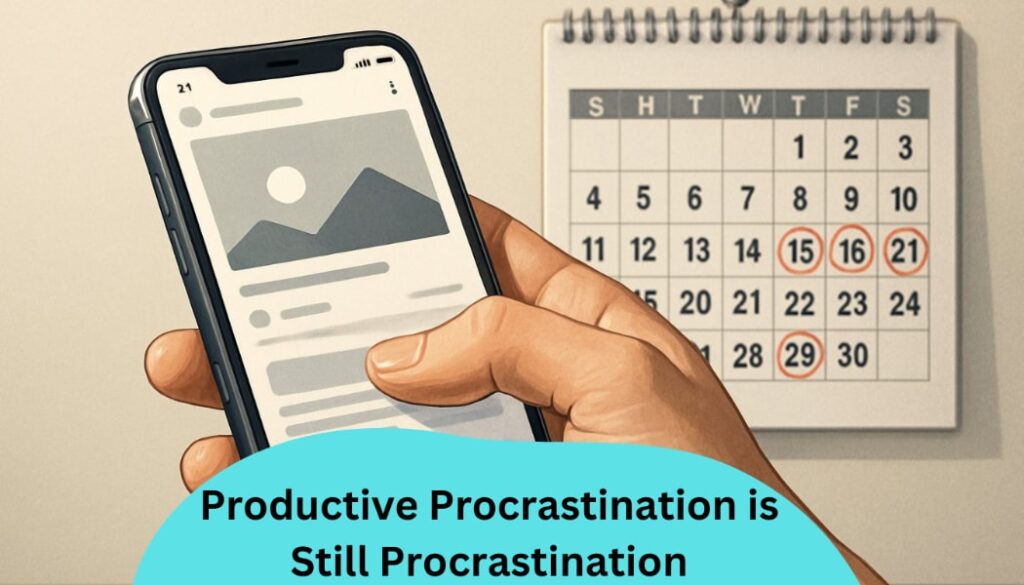Ever have a day where you feel really busy, but then realize that your most important tasks just haven’t moved forward at all?
Sure, you might have spent hours doing “stuff”, but the tasks that really needed your attention haven’t budged an inch?
That’s productive procrastination in action.
Struggling to Stay Consistent With Your Goals and Habits?
Book a free coaching call and see how accountability helps you take action every single day.

Unlike classic procrastination, where you zone out on social media or binge-watch shows, productive procrastination keeps you feeling “in the zone.”
The catch? You’re sidestepping meaningful progress without even realizing it.
So why is this important?
High performers often pride themselves on staying busy, but if that busyness isn’t tied to real results, it’s just well-disguised avoidance.
Understanding how productive procrastination creeps into your routine is a game-changer.
It lets you reclaim your focus, break out of the “I’m so busy” cycle, and start producing the kind of results that actually matter for your goals.
So, if you’re tired of feeling busy but not seeing results, it’s time for a wake-up call.
Let’s dive into how you can spot productive procrastination—and banish it before it wastes another day of your drive and ambition.

What Is Productive Procrastination (And Why It Feels So Good)
You know that satisfying feeling when you’re crossing off dozens of little tasks—but the project that truly matters isn’t moving an inch? That’s productive procrastination at its finest.
Productive procrastination is when you stay busy with work that looks important, but in reality, you’re avoiding the one thing that would actually move you forward.
Let’s shine a light on why it’s so tempting, and why you’re not the only one falling for it.
The Sneaky Appeal of Productive Procrastination
Productive procrastination is a master of disguise. Instead of flaking out on your responsibilities with obvious distractions (I’m looking at you, YouTube), you fill your time with things that “look” meaningful.
- Clearing out your inbox
- Tweaking your workspace
- Fine-tuning your to-do list… again
These activities give you a hit of satisfaction and make you feel in control. But they rarely move the needle on your big goals.
Why does this feel so good?
Because you’re tricking your brain into thinking you’re making progress—without ever leaving your comfort zone.
Structured Procrastination: How It Masquerades as Progress
This isn’t just about distraction. Structured procrastination is a step beyond: it’s organizing your avoidance so it looks like progress.
I’ve been there myself, imagining that sorting files or outlining an entire future quarter equals productive living.
The reality? You’re spending energy, but not always on what matters most.
Structured procrastination can make you believe that keeping busy means you’re making big changes.
Common Tasks That Feel Productive but Miss the Point
If you’re not careful, your day gets jammed with “productive” but low-impact work.
Some classics:
- Updating your professional bio or LinkedIn profile while a key deadline slips by
- Tidying digital files when there’s a major report due
- Watching tutorials instead of applying what you already know
I catch myself in these traps more often than I’d like to admit! They’re comforting because they seem active, but they’re just sophisticated avoidance tactics.

The Productive Procrastinator: Are You Wearing This Disguise?
If you’ve ever found yourself knee-deep in color-coded schedules, yet somehow your biggest goals still refuse to budge, you might be what’s known as a productive procrastinator.
This is the person who moves at lightning speed through mountains of tasks—just not the ones that truly matter. On the surface, a productive procrastinator looks like the poster child for hustle (all those sticky notes, all that energy!), but underneath, it’s avoidance wrapped in impressive packaging.
Let’s walk through a day in the life of a productive procrastinator. Maybe you’ll see yourself—or at least someone you know.
The alarm goes off. Instead of diving into your most important work, you start by updating your calendar. A fresh start, right?
Next, you check your email—just to “clear the decks” before you tackle that big pitch or proposal. As the morning rolls on, you realize you’ve answered every message, commented on three team threads, and even forwarded a couple of interesting articles to colleagues. Still, your high-leverage project sits untouched.
You grab another cup of coffee. Before starting that intimidating document, you decide to tidy your desktop. You reschedule a few meetings. Someone pings you on Slack and—naturally—you jump in to help (after all, you don’t want to appear unhelpful).
Noon rolls around and suddenly it feels like you’ve run a productivity marathon—but that key deliverable is still right where it was at sunrise.
Sound familiar? This persona gets a ton done, but not always the tasks that move the needle.
Is Your “To Do List” Helping—or Hiding the Real Work?
For the productive procrastinator, the to do list is a badge of honor. Every ticked box feels like a mini victory. But here’s the sneaky truth: loading up your list with low-risk errands, follow-ups, and “nice-to-haves” gives you the illusion of progress.
What gets left for last—or quietly carried over from day to day? The task that actually requires your focus and courage.
If you notice your most important job keeps slipping down the list, chances are your to do list is working against you, not for you.
The Allure of the “Side Project”
Another classic move for a productive procrastinator? Diving into a side project when the main event gets overwhelming.
Need to polish your website instead of making that uncomfortable phone call? Suddenly, it feels urgent. Side projects provide safe, satisfying work—and a handy excuse to avoid the high-stakes stuff that really shapes your future.
If you recognize yourself in this profile, don’t worry. Awareness is the first step to taking back your focus—and directing your drive where it counts most.

The Illusion of Progress: Why Being Busy Doesn’t Mean Being Effective
Ever had a full day of activity and ended it wondering, “What did I actually accomplish?” It’s not you—it’s the illusion of progress.
If you want real momentum, it’s time to separate motion from action and rewire how your brain thinks about work.
Motion vs Action: Understanding Structured Procrastination
Let’s clear things up: Motion is doing things that prepare you to get something done. Action is actually doing the thing that matters.
- Motion: Drafting endless outlines for your proposal.
- Action: Picking up the phone and closing the deal.
Motion feels safer. It delays risk. But it also means you finish your day out of breath, with zero forward movement.
For a deeper dive into this, check out James Clear’s analysis on motion vs. action—a simple read, but a real eye-opener.
Why Our Brains Prefer to Procrastinate Productively
Let’s get nerdy for a second: Your brain loves easy wins. Every time you check off a small task, it rewards you with a burst of dopamine.
That’s why answering emails feels good—even when it’s not urgent.
But that same support system can sabotage your bigger goals.
Big, challenging work comes loaded with risk (and potential failure), so your brain does everything it can to avoid discomfort by steering you toward “productive” distractions.
I’ll admit, I sometimes get hooked on low-hanging fruit when I’m feeling overwhelmed. The trick is spotting when this urge strikes—so you can consciously redirect it.
The Cost of Avoiding High-Leverage Work
All this busywork has a price. When you push aside your highest-impact tasks, you:
- Delay progress on big goals
- Sap your creative energy on small stuff
- Miss out on growth opportunities
Worse, productive procrastination creates a sense of false accomplishment that makes it harder to notice what you’re skipping out on.
I’ve had days where my calendar was full but my vision stood still. Don’t let busyness become your comfort zone.

5 Common Traps That Keep You in Productive Procrastination Mode
Most of us fall into the same “productive procrastination” traps again and again. Recognize any of these?
Trap 1: Over-Organizing Instead of Executing
It’s easy to mistake organizing for working. Color coding, reordering priorities, tweaking systems—all useful if your important tasks are already being tackled. Otherwise, it’s just unproductive procrastination.
Whenever I spend more time planning than actually doing, I know I’ve slipped into this trap.
Trap 2: Responding to Everything But Your Real Work
Nothing feels more urgent than answering messages right away. But if your day gets eaten up by replies, you’re letting other people’s priorities invade your focus zone.
One of my biggest game-changers? Delaying responses until my critical tasks are moving.
Trap 3: “Researching” Forever Before Starting
A quick bit of prep can bloom into endless “getting ready.” Reading three blog posts or watching a video is fine—spending days researching tiny details before starting? That’s avoidance dressed up to look diligent.
Ask yourself: “Is this research, or just prolonging action?”
Trap 4: Jumping Between Tasks Without Finishing
Ever bounce from one to-do to the next, always “busy,” nothing fully done? That’s the hallmark of productive procrastination. Multitasking rarely works for deep, focused results.
I used to pride myself on juggling; now, I know that finishing is where the magic happens.
Trap 5: Using Busyness to Procrastinate Productively
Filling your calendar to the brim doesn’t mean you’re using your time well. If busyness keeps you away from the hard work—the pitch, the proposal, the uncomfortable conversation—you’re using “I’m busy!” as a shield.
Busy is not the same as brave.

5 Ways to Refocus Fast and Reclaim Momentum
Let’s break the cycle. Here’s how you can shift out of productive procrastination and into real progress—without overhauling your entire workflow.
1. Use the “Real Priority” Filter
Before diving into any task, ask yourself: Is this the one action that creates meaningful results?
Try this:
- Pause for 10 seconds before starting something.
- Ask, “If I only got one thing done today, what should it be?”
If it’s just tidying, tweaking, or handling routine emails—it’s probably not your real priority.
I stick a post-it on my monitor with my daily “critical task”—and force myself to tackle it first.
Want more clarity on setting priorities? Here’s how to set the right priorities for real impact.
2. Time-Box the Busy Work with Time Blocking
No one can avoid all admin specific tasks, but you can confine them. Block off 20–30 minutes mid-afternoon for the “musts”—like emails or organizing.
Outside of that, focus on your high-leverage important tasks.
If you’re new to time blocking, Cal Newport’s has a good intro to it on his website: Time-Block Planner
3. Change Your Work Environment
Sometimes, a change of scenery does more to break unproductive procrastination than any self-talk. Move to a different room, a café, or even just stand up and stretch.
Personally, I have a “focus chair” in my office—when I sit there, it’s go time. Find what works for you.
4. Ask “What Am I Avoiding?”
If you feel the urge to reorganize or scroll aimlessly, stop and ask: “What am I really dodging right now?”
Often, it’s a meaningful task that feels big or a little scary. Naming the fear reduces its hold on you.
I journal about my avoidance triggers when this happens. It takes just a few minutes, but the insight is huge.
5. Create a Micro-Commitment to Start
The hardest part is often just getting started. Promise yourself you’ll spend just 5 minutes on that tough project. Nine times out of ten, once you start, you build momentum.
No, you don’t have to finish the whole thing right away—just prove to yourself that you can get started.
Read here for more on how small starts can build momentum and break procrastination.

What to Do When You Keep Slipping Back into Old Patterns
Okay, so you tried to focus. You fell right back into the email-black-hole or “I’ll just tidy” spiral. That’s normal.
Let’s talk about why mere awareness doesn’t solve everything—and what you can actually do to reset when you catch yourself slipping.
Why Awareness Isn’t Always Enough
Knowing you’re procrastinating productively is a solid first step. But let’s be honest—self-awareness doesn’t magically break the habit. The pattern is comforting, and your brain has been getting those “job well done” signals for a long time.
You may have caught yourself mid-procrastination, shrugged, and thought, “Eh, at least I’m not totally wasting time, right?” That’s the slippery slope back into old routines.
The takeaway here: Don’t beat yourself up. Slipping up is expected. What matters is how you respond in the next moment.
Build a Reset Routine That You Actually Use
Everyone needs a go-to ritual to shake off distraction and get back on purpose. A reset routine doesn’t have to be fancy—just something simple you’ll actually do.
Try this quick reset if you notice yourself drifting:
- Step away from your workspace. Physically moving breaks the pattern.
- Take three deep breaths. Center your attention on the present.
- Check your “one big thing” sticky note (or digital note). Re-orient your focus.
- Set a timer for 10 or 15 minutes. Commit to working on your productive task—just a short burst.
I’ve used this exact reset thousands of times. It’s a great way to make sure that I stay focused throughout my day.
How to Bounce Back Without Procrastinating Productively Again
Here’s what many don’t realize: It’s not about avoiding productive procrastination forever—it’s about recognizing when you’re doing it, and choosing anew, over and over.
Each time you return to your important task, you’re building “refocus” muscle. Over time, it becomes easier to spot avoidance and course-correct quickly—without judging yourself.
If you catch yourself in a spiral, pause, use your reset routine, and start again. Simple as that.
Remember, overall productivity is rarely about never falling off track. It’s about getting back on, faster and kinder, than you did before.

Are You Being Productive or Just Busy? Rethinking Daily Success
So, how do you know if you’re actually being productive… or just checking off boxes all day?
Let’s flip the script on what “success” at work or in life really means—because a packed schedule is often mistaken for meaningful progress.
Rethinking “Done” Lists vs Progress Lists
We all love a big “done” list at the end of the day. But what if you track progress instead of just activity?
Try keeping a simple Progress List:
- What did I move forward that mattered today?
- Did I chip away at something that will matter next week—or just knock off random minor tasks?
I started this habit after realizing my to-do lists just kept growing, while my big goals sat untouched. It was a tough but necessary wake-up.
How to Anchor Your Day to Intentional Actions with Time Blocking
If you want a foolproof way to avoid productive procrastination, anchor at least part of your day to focused, intentional work. This is where time blocking shines.
Choose your most important project and give it a dedicated slot—ideally during your peak energy. Treat it like a meeting with yourself. If the world survived while you missed emails for an hour, that’s proof you made the right choice.
And if you want more frameworks on intentional work, there’s a practical guide over on Todoist on time blocking and productivity.
Need more routine ideas? I wrote about building powerhouse evening routines—another way to set yourself up for focus the next day.
Focus Over Frequency: Doing Less, Better
It’s tempting to think that the more you do, the further you’ll get. But most progress happens when you do fewer things, better.
Those who excel aren’t superhuman—they’re selective.
If you find yourself saying “yes” to everything, check yourself. Ask “What could I drop (or delegate) that frees me up to hit home runs on what matters most?”
I’ll admit, cutting my list down felt uncomfortable at first. But the trade-off is more depth, less overwhelm, and actual progress you can measure—not just in productive tasks done but outcomes achieved.
If you want to see how this “less, but better” philosophy powers real growth, you might enjoy Greg McKeown’s book Essentialism. His take on narrowing your focus to the vital few really changed the way I plan my days and led to more overall productivity.

Want Help Staying Focused on What Truly Matters?
Even with your best intentions, staying locked in on high-leverage work can feel like running through an obstacle course—one packed with email notifications, endless research loops, and those sneaky productive distractions.
If you’re ready for a real shift, a little accountability can go a long way.
What Coaching Can Help You Do That Structured Procrastination Can’t
A coach doesn’t just hand you another productivity trick. The right coach challenges your comfort zones, calls you out on avoidance (with a gentle nudge), and helps you put your strengths to actual work where it really counts.
In my own journey, working with a coach helped me escape the busywork trap—and focus on actions that moved my biggest goals from “someday” to “done.” Sometimes, it takes an outside perspective to spot your own patterns.
Get Accountability Without Guilt or Overwhelm
Here’s the thing: you don’t have to go it alone, and you definitely don’t have to punish yourself for slipping into old routines.
Good accountability means:
- Setting a real priority filter for the week (so you’re not shuffling “important” tasks endlessly)
- Celebrating actual wins, not just full calendars
- Having someone call out when you’re stuck and not progressing
If you’re curious about how outside support can turbocharge your focus, let’s talk. Because there’s something truly powerful about having someone in your corner.
Book a Free Coaching Call and Stop Procrastinating Productively
Ready to shift from doing lots to doing what truly matters? If you want help breaking out of structured procrastination—for good—consider booking a complimentary coaching session.
Here’s how it works:
- We’ll review your biggest goals and the patterns holding you back
- I’ll help you spot your top time-drains (even the sneaky “productive” ones)
- You’ll leave with one clear, actionable step to focus your energy—starting today
Every day you hesitate is a day you can’t ever get back… so let’s make your next move the one that counts.
Final Thoughts: Cut the “Productive” Noise, Make Real Progress
Let’s face it—productive procrastination is comfortable, and sometimes even a little addictive. But staying stuck in busywork only gets you more of the same: Wasting time.
If you want real results, you’ve got to be honest about what’s truly moving you forward (and what’s just taking up oxygen on your to-do list).
You’ve got what it takes to shift from “busy” to bold. So go ahead—use these strategies, call out your own productive avoidance, and remember, you never have to do this alone.
If you’re looking for more encouragement, fresh ideas, or just a nudge to get going, take a look at the coaching program benefits and testimonials to motivate you.
And if something in this article sparked an “aha”—don’t just file it away. Act on it today. Your goals are waiting!
Ready to focus on what actually matters—and leave productive procrastination behind? Let’s make today count.





